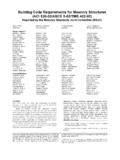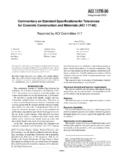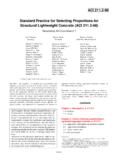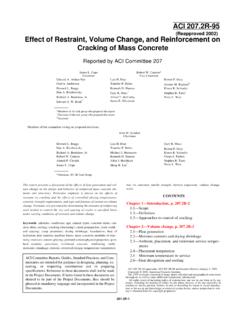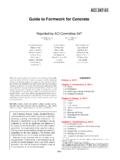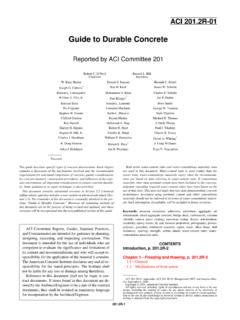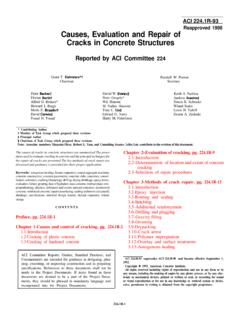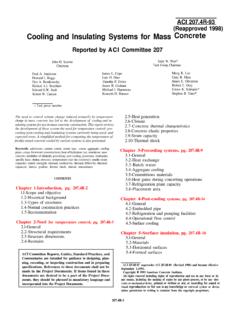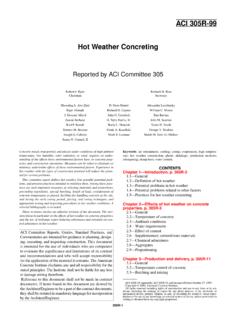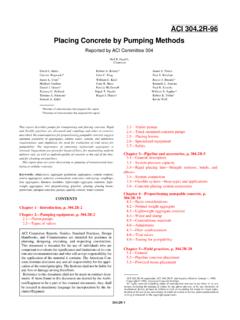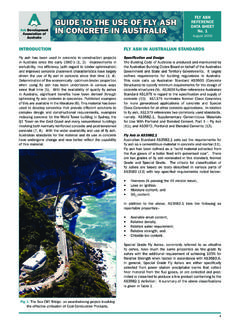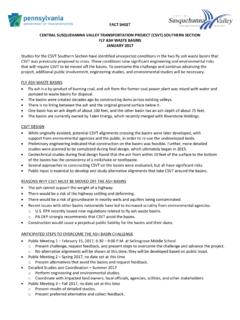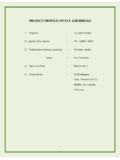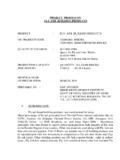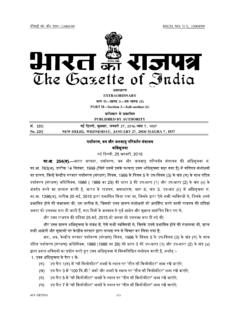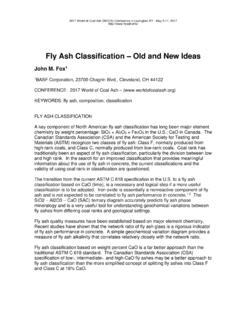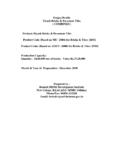Transcription of 211.4R-93 Guide for Selecting Proportions for High ...
1 ACI (Reapproved 1998) Guide for Selecting Proportions for high -StrengthConcrete with Portland Cementand Fly AshReported by ACI Committee211 Olga Alonzo*William L BarringerStanley G. BartonLeonard W. BellJames E. BennettMike Boyle*George BurgRamon L Carrasquillo*James E. Cook*Russell A. CookDavid A. CrockerGuy Detwiler*Gary R. MassChairmanCalvin L. DodlThomas A. Fox*George W. HollowTarif M. Jaber*Stephen M. LaneStanley H. LeeMark Luther*Richard C. MeiningerJames S. PierceMike Pistilli*Sandor Popovics*Steven E. RaganDonald E. Dixonl Members of subcommittee who prepared the Guide presents a generally applicable method for Selecting mixtureproportions for high -strength concrete and optimizing these mixture propor-tions on the basis of trial batches. The method is limited to high -stmngthconcrete produced using conventional materials and production and tables are based on current practice and infor-mation provided by contractors, concrete suppliers, and engineers who havebeen involved in projects dealing with high -strength : aggregates; capping; chemical admixtures; fine aggregates; fIy ash; high -strength concretes; mixture proportioning; quality control; specimen size;strength requirements; 1-Introduction, pg.
2 2-Performance requirements, pg. requirementsACI Committee Reports, Guides, Standard Practices, andCommentaries are intended for guidance in designing, plan-ning, executing, or inspecting construction and in preparingspecifications. References to these documents shall not bemade in the Project Documents. If items found in thesedocuments are desired to be a part of the Project Docu-ments, they should be phrased in mandatory language andincorporated into the Project SchlegelJames M. Shilstone, Jr.*Paul R. StodolaWilliam X. SypherAva Shypula*Jimmie L Thompson*Stanley J. VirgalitteWoodward L VogtJack W. WeberDean J. White, IItMarshall S. WilliamsJohn R. WilsonChapter 3-Fundamental relationships, pg. of materials ratio (w/c +p) measurementsChapter 4- high -strength concrete mixture proportion-ing, pg. proportioning procedureChapter 5-Sample calculations, pg. 6-References, pg. referencesCHAPTER current ACI mixture proportioning proce-ACI became effective September Q 1993, American Concrete rights reserved including rights of reproduction and use in any form or byany means, including the making of copies by any photo process, or by any elec-tronic or mechanical device, printed, written, or oral, or recording for sound orvisual reproduction or for use in any knowledge or retrieval system or device,unless permission in writing is obtained from the copyright ACI COMMITTEE REPORT dure describes methods for Selecting Proportions for nor-mal strength concrete in the range of 2000 to 6000 proportioning is more critical for high -strengthconcrete than for normal strength concrete.
3 Usually, spe-cially selected pozzolanic and chemical admixtures areemployed, and attainment of a low water-to-cementitiousmaterial ratio (w/c+p) is considered essential. Many trialmixtures are often required to generate the data neces-sary to identify optimum mixture Proportions . The pur-pose of this Guide is to present a generally applicablemethod for Selecting mixture Proportions for high -strength concrete and for optimizing these mixture pro-portions on the basis of trial in this Guide is limited to high -strengthconcrete produced using conventional materials andproduction methods. Consideration of silica fume andground granulated blast furnace slag (GGBFS) is beyondthe scope of this document. Information on proportion-ing of silica fume concrete is limited at this time. ACIC ommittee 234, Silica Fume in Concrete, is developinginformation on the use of silica fume for a committeereport.
4 Proportioning GGBFS concrete is discussed inACI 226-1R (now ACI Committee 233). When additionaldata becomes available, it is expected that an ACI guidefor proportioning concrete with these materials will bedeveloped. Currently, silica fume and GGBFS suppliers,as well as experienced concrete suppliers, represent thebest source of proportioning information for concrete is defined as concrete that hasa specified compressive strengthf, of 6000 psi or Guide is intended to cover field strengths up to12,000 psi as a practical working range, although greaterstrengths may be obtained. Recommendations are basedon current practice and information from contractors,concrete suppliers, and engineers who have been involvedin projects dealing with high -strength concrete. For amore complete list of references and available publica-tions on the topic, the reader should refer to ACI 2-PERFORMANCE ageThe selection of mixture Proportions can be influencedby the testing age.
5 high -strength concretes can gain con-siderable strength after the normally specified 28-day take advantage of this characteristic, many specifica-tions for compressive strength have been modified fromthe typical 28-day criterion to 56 days, 91 days, or laterages. Proportions of cementitious components usuallyhave been adjusted to produce the desired strength at thetest age strengthACI 318 allows concrete mixtures to be proportionedbased on field experience or laboratory trial batches. Tomeet the specified strength requirements, the concretemust be proportioned in such a manner that the averagecompressive strength results of field tests exceed thespecified design compressive strength f, by an amountsufficiently high to make the probability of low testssmall. When the concrete producer chooses to selecthigh-strength concrete mixture Proportions based uponfield experience, it is recommended that the requiredaverage strength fc, used as the basis for selection ofconcrete Proportions be taken as the larger value calcu-lated from the following equationsf_ = f, + = , + (2-1)(2-2)where s =sample standard deviation in (2-l) is Eq.
6 (5-l) of the ACI 318 Building (2-2) is a modified version of Eq. (5-2) qcr = fc + - 500) of the modified ACI 318 because, to date,job specifications for high -strength concrete have usuallymore than 1 in 100 individual tests that will fall below 90percent of the specified strength. When job specificationscite ACI 318 acceptance criteria, Eq. (5-2) of ACI 318should be used instead of Eq. (2-2) of this the concrete producer selects high -strength con-crete Proportions on the basis of laboratory trial batches,the required average strength f, may be determinedfrom the equation(2-3)Eq. (2-3) gives a higher required average strengthvalue than that required in Table of the ACIB uilding Code (ACI 318). Experience has shown thatstrength tested under ideal field conditions attains only90 percent of the strength measured by tests performedunder laboratory conditions.
7 To assume that the averagestrength of field production concrete will equal thestrength of a laboratory trial batch is not realistic, sincemany factors can influence the variability of strengths andstrength measurements in the field. Initial use of a high -strength concrete mixture in the field may require someadjustments in Proportions for air content and yield, andfor the requirements listed below, as appropriate. Oncesufficient data have been generated from the job, mixtureproportions should be reevaluated using ACI 214 and ad-justed requirementsConsiderations other than compressive strength mayinfluence the selection of materials and mixture propor-tions. These include: a) modulus of elasticity, b) flexuraland tensile strengths, c) heat of hydration, d) creep anddrying shrinkage, e) durability, f) permeability, g) time ofHIGH-STRENGTH CONCRETE WITH PORTLAND CEMENT AND FLY , h) method of placement, and i) 3-FUNDAMENTAL of materialsEffective production of high -strength concrete isachieved by carefully Selecting , controlling, and pro-portioning all of the ingredients.
8 To achieve higherstrength concretes, optimum Proportions must be se-lected, considering the cement and fly ash characteristics,aggregate quality, paste proportion, aggregate-pasteinteraction, admixture type and dosage rate, and cement, fly ash , chemical admixture, andaggregate from various potential sources in varying pro-portions will indicate the optimum combination of mater-ials. The supplier of high -strength concrete shouldimplement a program of uniformity and acceptance testsfor all materials used in the production of Portland cement-Proper selection of the typeand source of cement is one of the most important stepsin the production of high -strength concrete. ASTM C 917may be useful in considering cement sources. Variationsin the chemical composition and physical properties ofthe cement affect the concrete compressive strength morethan variations in any other single material.
9 For anygiven set of materials, there is an optimum cement con-tent beyond which little or no additional increase instrength is achieved from increasing the cement Other cementitious materials-Finely dividedcementitious materials other than portland cement, con-sisting mainly of fly ash , ground blast furnace slag, orsilica fume (microsilica), have been considered in theproduction of high -strength concrete because of the re-quired high cementitious materials content and loww/c+p. These materials can help control the temperaturerise in concrete at early ages and may reduce the waterdemand for a given workability. However, early strengthgain of the concrete may be C 618 specifies the requirements for Class Fand Class C fly ashes, and for raw or calcined naturalpozzolans, Class N, for use in concrete. fly ash proper-ties may vary considerably in different areas and fromdifferent sources within the same area.
10 The preferred flyashes for use in high -strength concrete have a loss onignition no greater than 3 percent, have a high fineness,and come from a source with a uniformity meetingASTM C 618 Mixing water-The acceptability of the water forhigh-strength concrete is not of major concern if potablewater is used. Otherwise, the water should be tested forsuitability in accordance with ASTM C Coarse aggregate--In the proportioning of high -strength concrete, the aggregates require special consid-eration since they occupy the largest volume of any ingre-dient in the concrete, and they greatly influence thestrength and other properties of the concrete. Usually, high -strength concretes are produced with normal weightaggregates. However, there have been reports of high -strength concrete produced using lightweight aggregatesfor structural concrete and heavyweight aggregates forhigh-density coarse aggregate will influence significantly thestrength and structural properties of the concrete.
